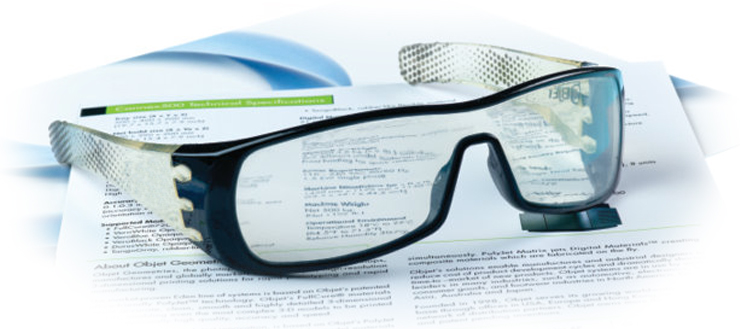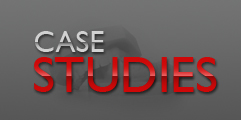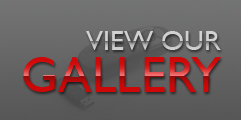Rapid Prototyping

What is Rapid Prototyping?
Rapid prototyping, like the name suggest, is the automated reconstruction of a prototype that was previously scanned by a 3D laser scanner or designed using CAD software. Using solid freeform fabrication or additive manufacturing technology, our printers are able to literally build your prototype, layer by layer, right in front of your eyes.

How does it work?
Using a CAD file (that you have designed with software, or created from a scan of the object), Objet printers are capable of manipulating the design and create successive layers of custom material, until your 3D prototype is completely built. Once printed, the model is completely functional and ready to use, test and reconfigure. You can customize the thickness of each layer to optimize accuracy or print quickly. For example, if you want a quick print, you would print layers that are 30 microns thick, and if you want the most accurate print possible, you would print each layer at 16 microns. The deviation from the original model is miniscule, as our industry leading capabilities can reproduce your model to within 16 microns (0.0016 centimetres). The advantage to this type or prototyping (additive fabrication) is that you can create any geometric figure you can imagine - the only limitation is your imagination.
What 3D Printers do we offer?
We offer a wide selection of printers.
How does this relate to 3D Printing?
A 3D prototype has to be printed somehow! Rapid prototyping and is a form of 3D printing and they are now synonymous in the 3D prototyping industry.
How does this relate to 3D Printing?
A 3D prototype has to be printed somehow! Rapid prototyping and is a form of 3D printing and they are now synonymous in the 3D prototyping industry.
What are the different types of rapid prototyping?
Polyjet Matrix Technology
Essentially, the PolyJet Matrix technology from Objet allows simultaneous multi-material 3D printing. This pioneering technology allows the simultaneous printing/layering of different material types. Polyjet uses a wide spectrum of UV acrylic based polymers to form 16-30 micron (0.0016-0.0030 centimetres) high-resolution layers. This dual-jet process combines different materials in various proportions so you can select a custom flexibility and feel for your 3D prototype. This technology offers you the ability to print prototypes made of more than one material, with different mechanical properties, in one easy print.
We use dual-jet technology to combine materials, which creates new composite materials tailored to your exact needs. Immediately after each layer is printed, it is cured by a UV light, which produces ready-to-use models that are very durable. Our technologies print a support material during the3D printing process which is easily rinsed off with water. Finally, because your prototype is built layer by layer, our technologies let you create moving parts that are ready to use right out of production!
Stereolithography (SLA)
This additive manufacturing process, which is similar to the above polyjet matrix printing, uses a combination of a UV laser and resin to construct rapid 3D prototypes one layer at a time. With data from a CAD model, the laser scans and traces each cross section on the exterior of the liquid resin. After a laser heats the resin to a solid, it becomes fused with the layer beneath it. The building tray lowers so the process can repeat and your model can be built one layer at a time. After construction is complete, the prototype is immersed in a chemical bath that removes and excess resin. The product is cured by a UV laser light, which immediately follows each printing jet, to complete the process.
After a pattern has been traced, the SLA's elevator platform descends by a single layer thickness, typically 0.05 mm to 0.15 mm (0.002" to 0.006"). Then, a resin-filled blade sweeps across the part cross section, re-coating it with fresh material. On this new liquid surface the subsequent layer pattern is traced, adhering to the previous layer. A complete 3D part is formed by this process. After building, parts are cleaned of excess resin by immersion in a chemical bath and then cured in a UV oven.
Fused Deposition Modelling (FDM)
Like all other additive manufacturing technologies, FDM starts with an STL file from a CAD software. Two materials are dispensed from this rapid prototyping machine. One material is for support, while the other is for the model itself. A CAD file defines a path for melted thermoplastics to travel and the model is built up, layer-by-layer, which is eventually cooled into a solid. Although different materials cannot be combined in this form of rapid prototyping, different materials can be used.
FDM technology common uses:
Functional testing
Product end-use
Ramping up production, while waiting for tooling
One of a kind products
Low-volume production
Limited/special edition products
Jigs and fixtures
Design verification
Replacement part manufacturing
Horizontal build layers can be built in three options ranging from .007" to.013". The minimum wall thickness must exceed .020". Models made from ABS maintain tolerances of +/- .005" for the first inch, and +/- 0.002" for each additional inch. In the z height (vertical), there are standard tolerances of +/- 0.010" for the first inch, +/- 0.002” on every inch thereafter. The build size for a single piece is 10" x 10" x 12". This does not restrain you, however, because models that are larger than the build enclosure can be divided, printed as separate pieces and assembled.
Selective Laser Sintering (SLS)
A high powered laser is used in this additive manufacturing technique. Our technology allows the laser to fuse tiny metal, plastic, glass or ceramic particles into a 3D model. SLS machines also use CAD files to help produce the prototype, and selectively fusing powdered materials. This fusing is achieved by scanning cross-sections, which are also generated from CAD data. After each section has been scanned, the base of the machine is lowered, in order to apply the next layer. This additive manufacturing technique also permits a wide use of materials. A great selection of polymers (such as polystyrene, nylon, titanium, alloys and steel mixtures) are available for your unique rapid 3D prototype.
Direct metal laser sintering (DMLS)
This process allows for highly complex geometries to be created directly from the 3D CAD data, fully automatically, in hours and without any tooling. DMLS produces parts with high accuracy and detail resolution, good surface quality and excellent mechanical properties.








